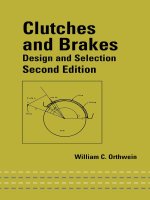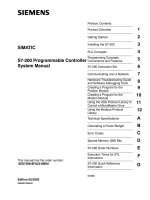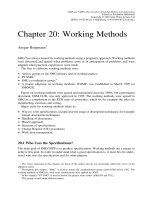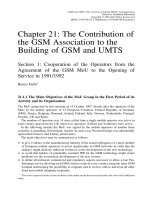Tài liệu Clutches and brakes design and selection P9 ppt
Bạn đang xem bản rút gọn của tài liệu. Xem và tải ngay bản đầy đủ của tài liệu tại đây (893.56 KB, 38 trang )
9
Centrifugal,One-Way,andDetent
Clutches
Thesearespecial-purposeclutchesthatareusedinautomatictransmissions,
indevicesforbringinghigh-speedmachineryuptospeed,inchainsaws,in
conveyordrives,andinsimilarindustrial,vehicular,andlarge-andsmall-
equipmentapplications.Thecentrifugalclutchesprovideaspeed-dependent
torquewhichactsonlywhentherotationalspeedexceedsaparticularvalue;
theone-way,oroverrunning,clutchesprovideatorquethatisnotspeedde-
pendentoncetheyareengaged,butisdependentonthedirectionofrota-
tion;andthedetentclutchesprovideatorquethatcannotexceedaprescribed
value.
I.CENTRIFUGALCLUTCHES
Acentrifugalclutchmaybedescribedasconsistingofaninnercylinderthatis
attachedtotheinputshaftandanouterhousingthatisattachedtotheoutput
shaft,asinFigure1.Sectorsoftheinnercylinderarecutouttoallowittobe
fitted with weights that can slide radially outward as the inner cylinder rotates
so that the weights are forced against the outer housing by centrifugal force
and thereby transmit torque to the outer housing. Centrifugal clutches de-
signed for lower power transfer may use simpler designs. In some chain saws,
for example, it is the weights themselves that are recessed to accept radial
guides from the central shaft.
Copyright © 2004 Marcel Dekker, Inc.
Because of the variety of centrifugal clutch designs, their analysis will be
described in general terms. Let A denote the cross-sectional area of each
weight in a plane perpendicular to the axis of rotation, written in the form of
an annular sector of angle f
o
as
A ¼ cf
o
r
2
o
ð1 À h
2
Þð1-1Þ
where h = r
i
/r
o
. Parameters h and c are factors that may be used to express
other cross-sectional areas in this form of equation (1-1). When h =0,c = 1/2,
and f
o
=2k, area A in equation (1-1) becomes that of a disc of radius r
o
.
Let w denote the width of each weight, measured in a direction parallel
to the axis of rotation, and let g represent the mass density of the weights. If
F
IGURE
1 Centrifugal clutch. (Courtesy Dana Corp., Inc., Toledo, OH.)
Chapter 9192
Copyright © 2004 Marcel Dekker, Inc.
thestaticdeflectionofaretainingspringattachedtoeachmassisy
s
,thenits
springconstantkisgivenby
k¼gA
wg
y
s
ð1-2Þ
inwhichgistheaccelerationofgravity,takentobe9.8067m/sec
2
,or32.2ft/
sec
2
.
Denotetheradiustothecenterofgravityofeachweightbyr
c
.Thenthe
centrifugalforceactingoneachweightasitrotatesatangularvelocity
x
abouttheaxisoftheclutchandmovesoutwardadistanceyisthengivenby
F¼gwAðr
c
þyÞ
x
2
Àgn
yþy
s
y
s
ð1-3Þ
wherethespringconstantmaybeincreasedbythefactorntoholdeachweight
moresecurelyagainstitsstopatlowrotationalspeeds.
Consideraprototypeweightasbeingmadefromasectorofathick
cylinderwhoseinnerradiusisr
i
andwhoseouterradiusisr
o
.Formthesector
bycuttingthecylindertolengthw,whichwillbethewidthofthesector,and
thencutthecylinderwithtworadialplanesseparatedbyanglef
o
.Retainone
ofthetwosectorsthatsubtendanglef
o
astheprototypeweightshowninlater
Figure3(a).Theradiusofgyrationofthisweightabouttheaxisoftheoriginal
cylinder is given by
r
c
¼
r
o
ffiffiffi
2
p
ffiffiffiffiffiffiffiffiffiffiffiffiffiffi
1 À h
2
p
ð1-4Þ
In order to express the radius of gyration of other geometries in this form,
let
r
c
¼ Er
o
ffiffiffiffiffiffiffiffiffiffiffiffiffiffi
1 À h
2
p
ð1-5Þ
The torque that can be delivered by N of these weights after they have
moved outward a distance y to make contact with the inner surface of the
housing at radius r
o
may be written as
T ¼ Ar
o
F ¼ Agwr
o
NA ðr
c
þ yÞ
x
2
À gnð1 þ DÞ
ÂÃ
ð1-6Þ
where D = y/y
s
. This relation may be solved for the w required for the clutch
to transmit torque T at angular speed
x
to get
w ¼
T
NAgf
o
cr
3
o
ð1 À h
2
Þ
ðr
c
þ yÞ
x
2
À gnð1 þ DÞ
!
ð1-7Þ
Centrifugal, One-Way, and Detent Clutches 193
Copyright © 2004 Marcel Dekker, Inc.
Maximumpressureontheliningmaybefoundfrom
F¼r
o
w
Z
f
o
=2
Àf
o
=2
pcosf
x
¼r
o
wp
max
Z
f
o
=2
Àf
o
=2
cosðfÞ
2
df
¼
p
max
2
r
o
wðf
o
þsinf
o
Þ
ð1-8Þ
uponusingthepressuredistributionfromequation(1-2)inChapter4.Hence,
p
max
¼
2F
r
o
wðf
o
þsinf
o
Þ
ð1-9Þ
Theangularvelocityoftheinputshaftwhentheweightsmakeinitial
contactwiththedrummaybefoundbysettingthesquarebracketinequation
(1-6)equaltozero.Substitutionof
x
=2kn/60,wherenisinrpm,followedby
solvingtheresultingexpressionforn,yields
n¼
k
30
ffiffiffiffiffiffiffiffiffiffiffiffiffiffiffiffiffiffiffiffiffiffiffiffiffiffiffiffiffiffiffiffiffiffiffiffiffiffi
n
g
r
c
ðhÞþy
ð1þDÞ
r
ð1-10Þ
TheroleofparametershandEinequation(1-5)uponforceF,equation
(1-3),andthereforeuponp
max
,equation(1-9)andthespeedatwhichtheyfirst
contactthedrumareshowninFigures2(a)through(d).
Observethatthevariationofthepressure,andhencetheforce,thateach
weightexertsagainstthedrumisalinearfunctionofparameterEandthatit
becomesanearlylinearfunctionofh,andhenceofr
i
,forhgreaterthanabout
0.3.Thedependenceofthewidthofeachweight,however,becomesincreas-
inglynonlinearashincreasesandasEdecreases.Therotationalspeedfor
initialcontactisalsonearlylinearforh<0.6,especiallyforthelargervalues
ofE.
Example
Designacentrifugalclutchtoprovideatorqueof2400N-mwhentherota-
tionalspeedreaches870rpmusingsectorweightshavingthegeometryshown
inFigure3(a).Preferredcharacteristicsarethatinitialcontactbetween
weightsanddrumoccuratbetween220and230rpmandthatthewidthof
theweightsbelessthan30cm.Assumealiningcoefficientoffrictionof0.35
anddesign foraninsidedrumradius(minustheliningthickness)of15cm,a
displacementyof3mmforthe segments to contact the drum, and a static
deflection of 1 mm. The segments are to be made from an iron alloy having a
nominal density of 7880 kg/m
3
, and a safety factor of 3.5 is mandated. Hold
Chapter 9194
Copyright © 2004 Marcel Dekker, Inc.
F
IGURE
2 (a) Variation of pressure (kPa) with h for E = 0.2, 0.4, 0.6, and 0.8 for
curves 1, 2, 3, and 4, respectively. (b) Variation of width (cm) with h for E = 0.2, 0.4,
0.6, and 0.8 for curves 1, 2, 3, and 4, respectively. (c) Variation of pressure (kPa)
with E for h = 0.2, 0.4, 0.6, and 0.8, respectively. (d) Variation of contact speed
(rpm) with E for h = 0.2, 0.4, 0.6, and 0.8 for curves 1, 2, 3, and 4, respectively.
Centrifugal, One-Way, and Detent Clutches 195
Copyright © 2004 Marcel Dekker, Inc.
F
IGURE
3 (a) Sector cross section. (b) Curve 1: pressure P (kPa) vs. h; Curve 2:
initial contact speed n (rpm) vs. h. (c) Sector width w (cm) vs. h.
Chapter 9196
Copyright © 2004 Marcel Dekker, Inc.
theweightsagainsttheirrestpositionwithaforce1.2timestheirweight.
Maximumliningpressureoflessthan440kPaispreferred.
Becausetheliningpressureonasegmentdecreaseswithangleufromthe
centerlineofthatsegmentaccordingtoequation(4-2),usesixweightstogeta
greaterforcetransfer,eachsubtendingananglef
n
=42j.
Beginthedesignprocessbyplottingpressurep,contactspeedn,and
widthwagainsthbysubstitutingthefollowingvaluesintoequations(1-1)
through(1-3),(1-5)through(1-7),and(1-9).
T¼24;000N-mr
o
¼150mg¼7880kg=m
3
n¼870rpmc¼0:50
y¼0:003my
s
¼0:001mn¼1:2f
o
¼42jA¼0:35
D¼3N¼6E¼
1
ffiffiffi
2
p
g¼9:8067m=sec
2
TheseplotsareshowninFigure3(b)and(c).
Figure3(b)showsthataninitialcontactspeedbetween220and230rpm
maybehadforhbetween0.6and0.7,Figure3(c)showsthatthecorrespond-
ingwidthofthesectorwouldbelessthan30cm.Substitutingh=0.65into
equation(1-10)yieldsn=226.59rpm,whichiswithinthedesiredrange.This
iscloseenoughtothepreferredvalueof225rpmformanualiterationofhto
findthat
n¼225:001rpmath¼0:6367
Thewidthofeachweightandthemaximumliningpressurecorrespondingto
h=0.6357arefoundtobe
w¼23:8cmandp
max
¼304kPa
bysubstitutionintoequations(1-7)and(1-9),respectively.Therequired
springconstantmaybefoundbysubstitutingfromequation(1-1)into
equation(1-2)toget
k¼wcf
o
r
2
o
g
g
y
s
nð1Àh
2
Þð1-11Þ
Substitutionintothisexpressionyields
k¼1366N=mm
II.ONE-WAYCLUTCH:THESPRINGCLUTCH
Wiebuschgavethefirstdescriptionofthisclutch,showninFigure4,in1930
[1]. As may be soon from the figure, it consists of a helical spring snugly,
wrapped about both the input and output hubs, parts 1 and 3 in Figure 4, but
is attached to neither of them. If the input hub tends to turn in the direction
that causes the helix to tighten, the increased friction between the spring and
hubs tends to resists any further relative rotation. Relative rotation in the
Centrifugal, One-Way, and Detent Clutches 197
Copyright © 2004 Marcel Dekker, Inc.
other direction, however, tends to loosen the helix, and relative rotation may
proceed with only a relatively small restraint by the spring clutch.
Although Wahl [2] appears to have derived a more accurate expression
for the torque that may be transmitted, T
t
, agreement between the Wiebusch
theory and experiment seems to be close enough to justify use of the simpler
relationship, which is
T
t
¼ Elr
h
1
R
2
À
1
R
1
e
2kNA
À 1
ÀÁ
ð2-1Þ
in terms of the elastic modulus E of the spring material, the moment of area I
of the spring wire in bending, the radius R
1
of the neutral surface of the wire in
helix 4 in Figure 4 when it is free of external load, the radius R
2
of the wire
when the helix is in tight contact with hubs 1 and 5 in the figure, and the
number of turns N on one hub if both hubs have the same number of turns. If
both hubs do not have the same number of turns, N is the smaller of the two.
The friction coefficient is represented by A, and r
h
denotes the hub radius.
Wiebusch found that the torque T
u
in the unwinding direction was
approximately equal to
T
u
¼ Elr
h
1
R
2
À
1
R
1
1 À e
À2kNA
ÀÁ
ð2-2Þ
F
IGURE
4 Spring clutch and its components. (Courtesy Warner Electric Brake &
Clutch Co., South Beloit, IL.)
Chapter 9198
Copyright © 2004 Marcel Dekker, Inc.
Equation(2-1)obviouslyholdsforatorquelessthanthatwhichcor-
respondstothemaximumforcethancanbecarriedbythespringwireatyield.
KaplanandMarshall[3]haveindirectlysuggestedthatthelimitingtorque
satisfiestheinequality
T
max
Ðbt
2
1:05
2r
h
R
1
ÀR
2
À
t
2
ð2-3Þ
forrectangularwirewhosedimensionintheradialdirectionistandwhose
dimensionintheaxialdirectionofthehelixisb.
III.OVERRUNNINGCLUTCHES:THEROLLERCLUTCH
TheseclutchesaredesignedtotransmittorquefromshaftAtoshaftBwhen
shaftAtendstorotatefasterthanshaftBbuttodisengagewhenshaftB
rotatesfasterthanA.Detailsoffourdesignsthataccomplishthisareshownin
Figure5,whichshowsthattheclutchconsistsoftwoconcentricraces,in
which one is circular and the other consists of a series of cams, with a roller
under, or above, each cam. Relative rotation which wedges the rollers be-
tween the narrow portion of the cam and the circular surface of the other race
forces both races to rotate together, while relative rotation in the opposite
direction frees the rollers and allows the two races to rotate at different an-
gular rates.
In particular, if the cams are cut in the outer race and tapered in the
direction shown in Figure 5(a), (b), and (c), rotation of the inner race in the
clockwise direction will cause the rollers to wedge themselves between the two
races so that the outer race must also rotate in the clockwise direction, that is,
when
x
i
>
x
o
If the outer race is then accelerated to a rotational speed greater than that of
the inner race so that
x
o
>
x
i
the roller will move to the larger ends of the cam and the outer race is free to
accelerate to a speed greater than that of the inner race. The sequence just
described is, for example, that used in starting gas turbines with an electric
motor to get them up to operating speed, at which point the turbine accel-
erates under its own power and disengages the starter motor, which is then
shut off.
If the cam surface is cut in the inner race and tapered as shown in Figure
5 (d), clockwise rotation of the outer race will drive the inner race whenever
x
o
>
x
i
Centrifugal, One-Way, and Detent Clutches 199
Copyright © 2004 Marcel Dekker, Inc.
Accelerationoftheinnerraceintheclockwisedirectionwillcausetheclutch
todisengagewhenever
x
o
<
x
i
asisobviousfromthetapergeometry.Theseclutchesaresaidtobefree-
wheelingoroverrunningwhentherelativerotationoftheraceissuchthatno
torqueistransmittedfromonetotheother.
FromthegeometryofFigures5itfollowsthatthetorquetransmittedto
a roller and a convex race is limited by the maximum contact stress that can be
sustained along the line of contact (actually, a narrow strip after the surfaces
have deformed slightly) between the roller and the race with the smaller radius
of curvature.
j
xx
¼
À2F
k
2
a
ða
2
þ 2x
2
þ 2z
2
Þ
z
a
C À 2k
z
a
À 3xzA
þ Að2x
2
À 2a
2
À 3z
2
ÞA þ 2Ak
x
a
þ 2Aða
2
À x
2
À z
2
Þ
x
a
C
ð3-1aÞ
j
zz
¼À
2F
k
2
a
zðaC À xA þ AzAÞð3-1bÞ
j
xz
¼À
2F
k
2
a
z
2
A þ Aða
2
þ 2x
2
þ 2z
2
Þ
z
a
C À 2kA
z
a
À 3AxzA
hi
ð3-1cÞ
away from the contacting surfaces and by
j
xx
¼ÀA
4F
ka
x
a
À
x
2
a
2
À 1
1=2
"#
; x ð a
¼À
2F
ka
1 À
x
2
a
2
1=2
þ 2A
x
a
"#
; Àa V x V a ð3-2aÞ
j
xx
¼ÀA
4F
ka
x
a
À
x
2
a
2
À 1
1=2
"#
; x Ð À a
If a finite element analysis program with contact stress capability is not
available, the pertinent stress components may be estimated from an analysis
by Smith and Liu [4] for the contact (Hertzian) stresses between two parallel
Chapter 9200
Copyright © 2004 Marcel Dekker, Inc.
F
IGURE
5 Typical roller clutch configurations. (a) Outer cam type of roller one-way
clutch diagram. (b) Caged roller type of clutch diagram (hook-type cam). (c) Loose
roller type of clutch diagram (leg-type cam). (d) Inner can type of roller one-way
clutch diagram. (Reprinted with permission; D 1984 Society of Automotive
Engineers, Inc.)
Copyright © 2004 Marcel Dekker, Inc.
F
IGURE
5 Continued.
Chapter 9202
Copyright © 2004 Marcel Dekker, Inc.
cylinders, such as between the rollers and the inner races in Figure 6 (a), (b),
and (c).
j
zz
¼À
2F
ka
1 À
x
2
a
2
1=2
; Àa Ð x Ð a
¼ 0; x Ð À a; x ða
ð3-2bÞ
F
IGURE
6 Forces on cam and race in an overrunning roller clutch.
Centrifugal, One-Way, and Detent Clutches 203
Copyright © 2004 Marcel Dekker, Inc.
j
xz
¼À
2F
ka
A 1 À
x
2
a
2
1=2
; Àa Ð x Ð a
¼ 0; x Ð À a; x ð a
ð3-2cÞ
on the contacting surface. For larger values of A the maximum stress is on the
surface and for smaller values it lies below the surface. Quantities A and C in
equation (3-1) are defined by
A ¼
k
k
1
f
1 À
k
2
k
1
1=2
"#
C ¼
k
k
1
f
1 þ
k
2
k
1
1=2
"#
f ¼ 2
k
2
k
1
1=2
k
2
k
1
1=2
þ
k
1
þ k
2
À 4a
2
2k
1
"#
1=2
where
k
1
¼ða þ xÞ
2
þ z
2
k
2
¼ða À xÞ
2
þ z
2
a ¼ 2
E
k
1 À v
2
1
E
1
þ
1 À v
2
2
E
2
1
r
1
þ
1
r
2
0
B
B
@
1
C
C
A
1=2
Quantities v
1
, v
2
, r
1
, r
2
, E
1
, and E
2
refer to the Poisson ratios, radii, and
Young’s moduli of the components in contact, i.e., a roller and the outer race
or a roller and the inner race. Since the trios of quantities v
1
, r
1
, E
1
and v
2
, r
2
,
E
2
enter symmetrically into the expression for a, either trio may be associated
with a roller and the other trio associated with the inner race. Coordinates x
and z lie in the circumferential and radial directions, respectively, and
quantity a represents the half-width of the contact area measured in the
circumferential direction, hence the inclusion of F in the definition of a.
Loading force per unit length in the axial direction between a race and a roller
is denoted by F. One misprint and one apparent misprint have been corrected
by the author in reproducing equations 4 and 12 in Ref. 4 in the preceding set
of equations.
Maximum compressive stress at the surface between a roller and a
concave race is given by
j
zz
¼
À1
k
F
1
r
1
À
1
r
2
1 À v
2
1
kE
1
þ
1 À v
2
2
kE
2
2
6
6
6
4
3
7
7
7
5
1=2
ð3-3Þ
from Ref. 5.
Chapter 9204
Copyright © 2004 Marcel Dekker, Inc.
Insertion of the force F used to calculate the previous stresses into
equation (3-3) will give the torque transferred to the outer ring as
T ¼ FNl r
1
þ r
3
ðl þ cos aÞ½ðsin a þ A cos aÞð3-4Þ
in terms of the angle a between F
1
and the direction of F
2
, the length/of each of
the rollers, the number of rollers, N, the radius r
1
, and the radius of a roller, r
3
.
Forces acting on a roller as it is wedged between the inner and outer
races are shown in Figure 7. Summing forces in the direction of F
1
yields
F
2
cos a þ A
2
F
2
sin a ¼ F
1
ð3-5Þ
and summing forces perpendicular to the direction of F
2
yields
F
2
sin a ¼ A
2
F
2
sin a þ A
1
F
1
ð3-6Þ
From Figure 7 we note that the magnitude of the force transmitted to
the outer race is given by F
2
(sin a À A
2
cos a). This force would reach its max-
imum and the shear stress on the roller and outer race would vanish if only a
normal force acted between a roller and the outer race or, more precisely, the
F
IGURE
7 Forces acting on a roller wedged between an outer cam and and the
inner race.
Centrifugal, One-Way, and Detent Clutches 205
Copyright © 2004 Marcel Dekker, Inc.









